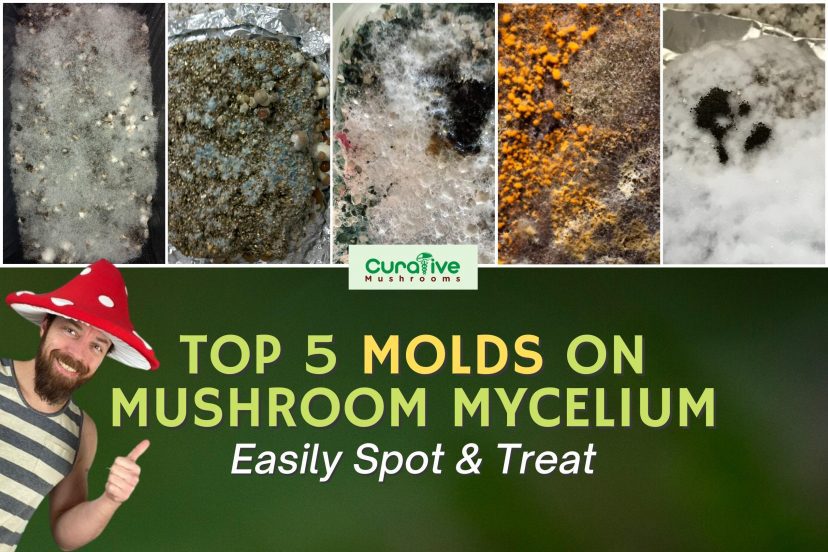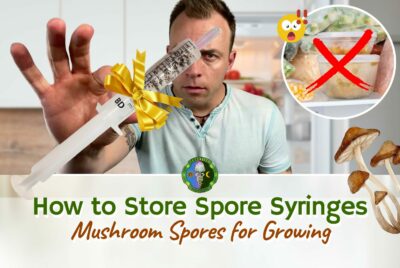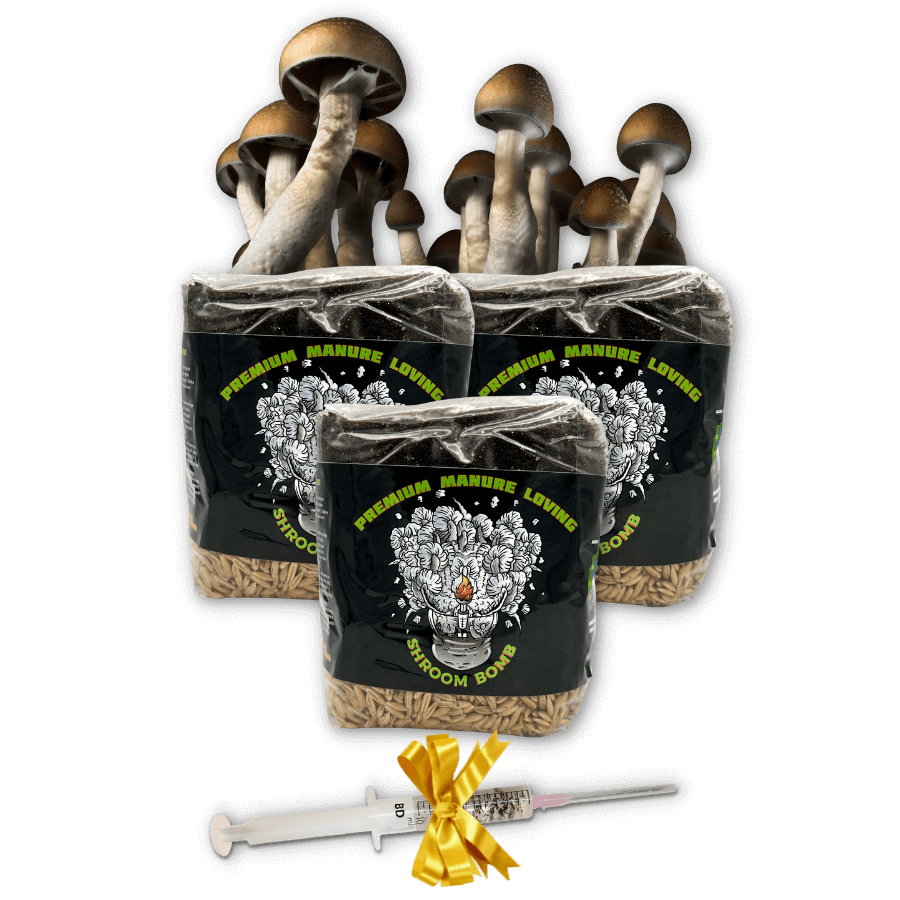Growing your own mushrooms at home can be a transformative experience, and if you're looking to…
Black, Green and Other Mold on Mushrooms Mycelium

Can mushrooms get moldy? Even the best mushroom grower cannot guarantee a mold-free mushroom growing experience. For sure, they will encounter mycelium mold and even mold on mushrooms from time to time.
Expectedly, molds are every mushroom grower’s number one enemy mainly because of how fast they can spoil your crop.
From spores, molds grow and become noticeable within 24 hours.
The ideal growing condition for mushrooms invites different types of molds like:
- Cobweb Mold (Hypomyces or Dactylium)
- Green mold (Trichoderma)
- Black mold (Stachybotrys)
- Orange-red bread mold (Neurospora)
- Black bread mold a.k.a pin head mold (Rhizopus)
Luckily, unlike other contaminations like bacteria and gnats, molds may be the simplest to treat. The key to treating mold on mycelium is by spotting them early on.
Mostly, all mushroom mold contaminations can be treated the same. That is if you are in the early phases of growing (before the fruiting body phase).
Now, the tricky part is identifying them and not mistaking them for other contaminations or as normal mushroom mycelium.
Do not worry as we will show you below what each mold contamination looks like and the different ways to treat them.
1. How to Spot Mold Contamination on Mushroom Mycelium
1.1 Cobweb Mold (Hypomyces or Dactylium)

Cobweb mold is a fast-growing mold with very fine white strands. For as short as 24 hours, it develops into a stringy gray mass.
Most of the time, it can be tricky to tell apart from the growing mycelium.

1.2 Green Mold on Mushrooms Substrate (Trichoderma)

Trichoderma spp., also known as green mold, frequently contaminates any type of mushroom substrates. Most probably, it is the most persistent and aggressive mushroom contaminant.
Usually, green mold begins growing on white mycelium with white or off-white color, maturing into olive color to dark green.
How to Get Rid of Green Mold on Mycelium
The fastest and strongest solution to get rid of the green mold spores is mixing laundry bleach, water, and vinegar.
Firstly measure a 1:10 ratio of laundry bleach. Then add it to water.
Mix all together and then combine the ingredients with the same ratio of vinegar.
Pour all into a little spray container and spread it all over the affected air area.
1.3 Black Mold on Mushrooms (Stachybotrys)

Black mold appears slimy black or highly dark gray, like black crayons on paper.
Also, this mold tends to have definite round splotches with a mottled appearance. Often, you see darker layers of mold over lighter layers.
Black mold is also a common problem in U.S. households. It is often attributed to water damage or leak. When it gets out of hand, homeowners could use some help from mold remediation service providers.
As a matter of fact, who would like to grow mushrooms in a mold-contaminated household? Mold spores are everywhere!
1.4 Orange-Red Bread Mold on Mushroom (Neurospora)

Orange and red bread mold appears irregularly cushion-shaped and soon becomes effuse and fluffy. Its color ranges from pale salmon, and orange, to red.
1.5 Black Bread Mold, a.k.a Black Pin Mold (Rhizopus)

Rhizopus is a common mold that grows on bread. It looks like a grayish fluffy mass and can be easily confused with Cobweb mold.
Over time, as Rhizopus begins to produce spores, the sporangium (the capsule structure appearing like a pin) becomes black.
2. How to Treat Contamination
2.1 Spray Hydrogen Peroxide ( H2O2)
Undeniably, hydrogen peroxide is an effective way to treat the early stages of mold. That is within 24 hours since visible mold contamination.
Oftentimes, mushroom cultivators advise spraying the surface mold with 3% hydrogen peroxide.
Fortunately, you do not need to create your solution since you can just buy over-the-counter. Hydrogen peroxide is sold in concentrations of 3 to 12 percent at most drug stores and online stores.
For this, you may use a clean spray bottle. Simply spray the whole surface area of your infected substrate or fruiting block with the solution.
In a blink of an eye, molds dissolve as they come in contact with the solution.
2.2 Isolate and Scoop Out the Contaminated Area

Before scooping any contaminated area of your crop, the first best thing to do is separate the mold-contaminated kit from healthy ones (supposing you have more than one grow kit).
However, scooping out the contaminated area of your crop seems like a desperate measure. Mold spores like Trichoderma are hard to contain once it gets ahold of your crop.
But if you’d like to take a chance with your mold-contaminated kit, you can try the following:
- Prepare your spoon (clean it with 70% isopropyl alcohol).
- Spray hydrogen peroxide on the surface of the crop.
- Put a clean damp paper on the mold blotch.
- Scoop it with your clean spoon.
If the mold on mycelium is smaller than a coin, your chance of saving your kit with the scoop-out method is higher.
2.3 Throw Your Mushroom Mycelium Block… Under a Tree

This may sound silly, but it sometimes works. Well, since you’ll throw it, you might consider giving it some dignity. lol
So instead of putting your contaminated mushroom block in a garbage can, you may put it in a proper resting place, under a tree or a pile of wood in your backyard.
Try to think of it. Mushrooms that grow in the wild need not have careful babysitting. They just thrive amidst all environmental challenges. Thus, the same thing may happen with your spoiled mushroom block.
Besides, if you give it a chance to flourish in its natural habitat, it may have a bigger chance of surviving. So just toss it under a tree and come back a week later to see if it has returned to life. 😉

Now, you have an idea of spotting these silly mold contaminants.
As a recap, the most common are green mold, black mold, orange bread mold, pinhead mold, and cobweb mold.
In addition, you can treat your contaminated block by spraying hydrogen peroxide, scooping out contaminated areas, or tossing it with dignity under a tree.
Always remember: once you spot contamination, immediately separate the healthy blocks. Also, in using any tools that will touch your substrate, sterilize them first with isopropyl alcohol or flame.*
Happy Mushroom Growing! 🙂








[…] Mold on Mushroom Mycelium (Top 5 Types): Easily Spot & Treat […]
mix vinegar and bleach, really?
I was saddened to find green mold starting in one corner. I e pulled it out from the other one immediately. Im hoping the other ones dont develop it i am leaning toward a still air box with some sort of air filtration. It suckes shoot!! Scott meserve
Hi, Scott. It’s good you separated the suspected contamination immediately. What treatment did you try to save the contaminated kit?
We bought a large block of oyster mushroom growing material from a permacukture grower friend . There were no instructions . We haven’t had time to study yet and put the block in an empty bedroom in our newly built Adobe home . Before we knew the mushrooms grew huge and we harvested those and poked holes for more growth . The next day we saw green mold and ann orange wooden sticklike substance . We hadn’t moved into the house yet still I had a bottle of hydrogen peroxide , no spray. With a disinfected spoon I dug out the mold and poured hydrogen peroxide on moldy areas then put the bag outside under a tree in the shade . We live in high desert and it’s the dry season . Was it safe to eat the mushrooms we ate yesterday and the ones that grow now ? Should we take the bag off ? I’m thinking what happened is my husband emptied the compost and without washing his hands made the holes in the growing bag . Is our bedroom now contaminated by mold ? Our daughter has inflamation issues and is very sensitive to mold as am
I . Thank you , Lucy Karrys
Hi, Lucy. The green mold (mostly Trichoderma mold) and wooden stick-like substance (Neurospora mold) in the contaminated block make it unsafe to eat the mushrooms. Please remove the block and properly dispose of it. If you are concerned about mold exposure in your bedroom, we recommend that you have a professional mold inspection performed. To avoid the spread of mold spores, avoid touching the contaminated block and thoroughly wash your hands after handling it. We hope this was helpful! 🙂
I really like the way your blog looks, and this content is fantastic. Thank you for sharing.
Thank you so much for your kind words! We’re thrilled to hear that you’re enjoying our blog and finding the content valuable.We’re here to provide helpful and informative content for our readers.
Best regards
curative mushrooms support
At harvest time mushrooms have black mold are they garbage or will dehydration eliminate mold issue?
So most of my mono tubs started to get green mold in them, and I tried various ways to get it to stop, nothing actually really worked. I did follow the advice by taking them outside and putting them by a tree, and incredibly they all started producing mushrooms, and most of the mold went away, which is so crazy, thanks for the tip !
Hey so im doing a grow when i sprayed the mycelium with water a lot of the white went away now its coming back but I’m getting things that almost look like black pinhead mold but they are black threwout nothing like the picture any thoughts?